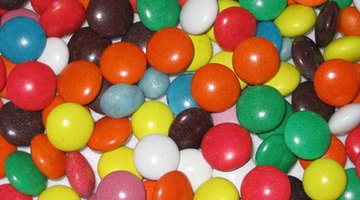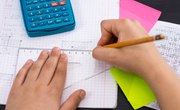Probability does not need to be an abstract concept. Although equations and formulas may be too advanced for elementary school students, simple probability can help students in making educated guesses and decisions. Analyzing and interpreting data allows your students to determine probability. Students engage in activities that are approachable and accessible, and using M&Ms is an effective visual aid. To top it off, students can enjoy their M&Ms as an after-class treat.
Lesson Prep
Step 1
Take M&Ms and plastic sandwich bags to a clean work area.
Step 2
Assemble packets of M&Ms (one per student). Between 20 and 30 candy pieces per plastic bag is plenty. Counting is not necessary, but recommended to give each student a fair share of candy.
Step 3
Place all items required for this lesson in a bag with a carrying handle.
Lesson
Step 1
Hand out lesson materials. Each student should receive one M&M packet, one piece of construction paper, two pieces of blank paper and two pieces of graph paper. Set out markers or crayons for all students.
Step 2
Encourage students to use the construction paper as a placemat. Tell them the candies may be enjoyed after the lesson if they behave appropriately.
Step 3
Instruct students to place candies on the construction paper. Tell them each bag has the same number of M&Ms, but everyone has a different number of colors because they were selected at random.
Step 4
Request that students record information based on the M&Ms on a blank piece of paper. Write these questions on the chalkboard: "How many M&Ms do you have?" "How many different colors do you have?" "How many of each color do you have?" "Which color has the most quantity? The least?"
Step 5
Write the definition of simple probability on the board. Use your own definition or use, "The probability of an event is the number of outcomes (favorable) divided by the total number of possible outcomes (assuming all outcomes are equally likely)."
Step 6
Have students record numbers in fractions or ratios. If the group of 20 candies contains 7 green pieces, the probability is expressed as 7/20 or 7:20. Guide the class through this process and write different probabilities on the board. Probabilities are numbers expressed commonly as fractions and ratios, but also as percents or decimals; feel free to write answers in these different forms.
Step 7
Ask students to determine the ratio of each M&M color to the entire bag. Students can predict the probability of selecting one color at random from their plastic bag with this information. Ask, "How many of each color is likely to be found in a handful of 10, or of 20?" Let them try this experiment, then discuss the results.
Step 8
Allow students to enjoy their candy after the lesson.
Tip
If you'd rather have your students work in teams, keep your classroom sanitary by saving the candy for later. Work with other small items such as dice, playing cards or game pieces.
Tip
Snack-sized, pre-packaged M&Ms also work well for this project.
Tip
Use the provided resource link for facts about the different colors of M&Ms to enhance learning.
Warning
Avoid purchasing seasonal M&Ms having only two or three colors. Use the standard variety of colors for this probability lesson.
Related Articles
References
Tips
- If you'd rather have your students work in teams, keep your classroom sanitary by saving the candy for later. Work with other small items such as dice, playing cards or game pieces.
- Snack-sized, pre-packaged M&Ms also work well for this project.
- Use the provided resource link for facts about the different colors of M&Ms to enhance learning.
Warnings
- Avoid purchasing seasonal M&Ms having only two or three colors. Use the standard variety of colors for this probability lesson.











